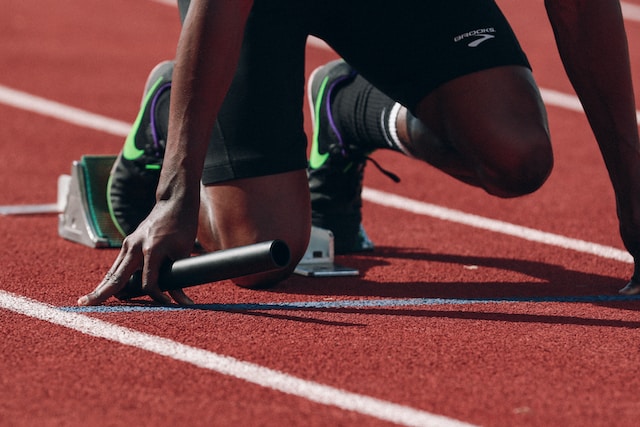Can calisthenics make you faster? If you’re looking to boost your speed and unleash your inner athlete, calisthenics might be the secret weapon you’ve been searching for. Calisthenics, the art of using your bodyweight for resistance training, has gained immense popularity in the fitness world. In this article, we’ll explore the fascinating relationship between calisthenics training and enhanced speed. Whether you’re a seasoned fitness enthusiast or just starting your fitness journey, these valuable insights will help you unlock your speed potential and take your performance to new heights. So, get ready to dive into the world of calisthenics and discover how it can make you faster than ever before.
Foundations of Calisthenics
Calisthenics training is built upon fundamental principles and exercises that form its core foundation. Understanding these principles and incorporating them into your training routine is essential for maximizing the benefits of calisthenics and enhancing your athletic performance. Let’s delve into the key elements that make up the foundations of calisthenics.
Fundamental Principles
Calisthenics revolves around bodyweight exercises that challenge and strengthen your muscles. These exercises focus on utilizing your body as resistance, rather than relying on external weights or equipment. By mastering proper form and technique, you can engage multiple muscle groups simultaneously, improving overall strength and coordination.
Strength Development
Calisthenics training targets various muscle groups, including the upper body, lower body, and core. Through exercises like push-ups, pull-ups, squats, lunges, and planks, you develop functional strength that translates into improved performance in everyday activities and sports. Strengthening these muscle groups enhances your ability to generate power, accelerate, and maintain speed during athletic movements.
Flexibility and Mobility
Calisthenics training also emphasizes flexibility and mobility, which play crucial roles in athletic performance. The dynamic movements and stretches involved in calisthenics exercises promote flexibility, allowing your muscles and joints to move through their full range of motion. Increased flexibility can enhance stride length, improve running form, and prevent injuries by reducing muscle tightness and imbalances.
Body Control and Coordination
Calisthenics requires a high level of body control and coordination as you navigate through various movements and exercise progressions. By practicing bodyweight exercises like handstands, muscle-ups, and planches, you develop body awareness, balance, and spatial orientation. These skills transfer to improved agility, quickness, and proprioception, allowing you to perform athletic movements more efficiently and effectively.
The development of strength, flexibility, and body control through calisthenics contributes significantly to improved athletic performance. By focusing on these foundational elements, you can enhance your speed, power, and overall athleticism. As you progress in your calisthenics journey, you’ll find that the strength and skills acquired in training seamlessly translate into various sports and physical activities. So, embrace the foundations of calisthenics, and watch your athletic performance soar to new heights.
The Science Behind Speed
Speed is a highly desirable athletic attribute, and understanding the scientific factors that contribute to it can help optimize training strategies. Several key factors influence speed, including stride length, stride frequency, and power output. Additionally, there are various physiological aspects involved in speed development, such as muscle strength, explosiveness, and coordination. Let’s explore the science behind speed and how calisthenics can directly impact these factors to enhance your speed potential.
Factors Influencing Speed
- Stride Length: The distance covered with each stride plays a crucial role in speed. Factors like leg strength, flexibility, and range of motion influence stride length.
- Stride Frequency: The number of strides taken per unit of time is another vital aspect of speed. It depends on factors such as muscular endurance, neuromuscular coordination, and running technique.
- Power Output: Power output refers to the ability to generate force quickly. It relies on muscular strength, explosive power, and efficient muscle activation.
Physiological Aspects of Speed Development
- Muscle Strength: Developing muscular strength, especially in the lower body, is essential for generating the force required for rapid acceleration and maintaining speed.
- Explosiveness: Explosive power, characterized by the ability to generate high levels of force in a short time, is crucial for quick starts, sudden changes in direction, and sprinting.
- Coordination: Speed requires the synchronized activation of muscles and precise movement patterns. Enhancing coordination through body control exercises improves efficiency and reduces energy wastage.
Calisthenics and Speed Enhancement
- Muscle Strength: Calisthenics exercises, such as squats, lunges, and pistol squats, target the major muscle groups involved in running, improving overall leg strength and power.
- Explosiveness: Calisthenics incorporates explosive movements like jump squats, explosive push-ups, and burpees, which develop fast-twitch muscle fibers and explosive power.
- Coordination: Calisthenics exercises like handstands, muscle-ups, and dynamic bodyweight movements enhance body control and coordination, translating to improved movement efficiency during sprinting and agility-based activities.
By engaging in calisthenics training, you can directly impact the factors that influence speed and enhance the physiological aspects crucial for speed development. Regular calisthenics workouts improve muscle strength, explosiveness, and coordination, all of which contribute to enhanced speed potential. Incorporating exercises targeting lower body strength, explosive power, and body control can specifically enhance your ability to sprint faster, accelerate quickly, and maintain speed over longer distances.
The science behind speed encompasses factors like stride length, stride frequency, and power output, while muscle strength, explosiveness, and coordination play vital roles in speed development. Calisthenics training directly impacts these factors, offering a comprehensive approach to enhancing speed potential. So, lace up your shoes, incorporate calisthenics into your training regimen, and unlock the speed you’ve always aspired to achieve.
Calisthenics Techniques for Speed Improvement
When it comes to improving speed through calisthenics, specific exercises can target the muscles and movements essential for maximizing your sprinting potential. Additionally, incorporating plyometric exercises can develop explosive power, while exercises focused on agility, coordination, and balance further enhance speed-related attributes. Here are some key calisthenics techniques to boost your speed:
Targeted Muscle and Movement Exercises
- Squats: Strengthening the quadriceps, hamstrings, and glutes improves lower body power, stride length, and acceleration.
- Lunges: Develop stability, balance, and leg strength, focusing on the quadriceps, hamstrings, and glutes.
- Calf Raises: Strengthen the calf muscles, essential for propelling your body forward during sprinting.
- Jumping Jacks: Enhance cardiovascular fitness, coordination, and lower body explosiveness.
- High Knees: Improve hip flexor strength, knee drive, and coordination while mimicking sprinting movements.
Plyometric Exercises for Explosive Power
- Box Jumps: Develop explosive power in the lower body, specifically targeting the quadriceps, glutes, and calves.
- Plyometric Push-Ups: Boost upper body explosiveness and strength through rapid and powerful push-up movements.
- Broad Jumps: Enhance lower body power and explosiveness, mimicking the forceful leg drive needed for sprinting.
Agility, Coordination, and Balance Exercises
- Lateral Bounds: Improve lateral explosiveness, hip stability, and agility.
- Agility Ladder Drills: Enhance footwork, coordination, and quick changes in direction.
- Single-Leg Balance Exercises: Enhance proprioception, stability, and ankle strength, which are vital for sprinting and changing direction efficiently.
Incorporating Exercises into a Training Routine
- Warm-up: Begin each session with dynamic movements like leg swings, arm circles, and light jogging to prepare your muscles and joints.
- Structured Progression: Gradually increase the intensity and difficulty of exercises to continually challenge your body and stimulate improvement.
- Training Variety: Mix up your exercises and routines to prevent plateaus and keep your training stimulating and engaging.
- Rest and Recovery: Allow adequate time for rest and recovery between sessions to avoid overtraining and promote muscle adaptation and growth.
Incorporating these exercises into a comprehensive calisthenics training routine will specifically target the muscles, movements, and attributes crucial for speed improvement. Remember to focus on proper form, gradually increase intensity, and listen to your body to prevent injuries. Consistency and dedication are key to achieving noticeable improvements in speed and overall athletic performance.
So, lace up your shoes, step onto the calisthenics mat, and let these techniques propel you towards your speed goals, unlocking the full potential of your athleticism.
Training Considerations and Precautions
When it comes to calisthenics training for speed enhancement, it’s crucial to approach it with careful consideration and take necessary precautions to maximize results and prevent injuries. Here are some practical tips to structure your calisthenics training plan, prioritize proper form, and incorporate adequate rest and recovery.
Structuring a Calisthenics Training Plan
- Warm-up: Begin each session with a dynamic warm-up to increase blood flow, warm up the muscles, and prepare the body for the upcoming exercises.
- Exercise Selection: Choose exercises that target the specific muscles and movements relevant to speed improvement, such as squats, lunges, plyometrics, and agility drills.
- Progressive Overload: Gradually increase the intensity, volume, or difficulty of exercises over time to continually challenge your body and stimulate adaptation. This can involve adding resistance, increasing repetitions, or progressing to more advanced variations.
- Consistency: Consistent training is key to see progress. Aim for regular training sessions, ideally 2-3 times per week, to allow for sufficient stimulus and adaptation.
Importance of Progressive Overload and Proper Form
- Progressive Overload: Gradually increasing the challenge placed on your muscles and cardiovascular system is essential for continuous improvement. However, it’s important to progress gradually and avoid sudden, excessive increases in workload to minimize the risk of overuse injuries.
- Proper Form: Focus on maintaining correct form and technique during exercises. This ensures optimal muscle engagement, reduces the risk of injury, and maximizes the effectiveness of the movement. Seek guidance from a qualified trainer or use instructional resources to learn and practice proper form.
Significance of Rest and Recovery
- Allow for Rest Days: Incorporate rest days into your training plan to give your body time to recover and adapt to the training stimulus. Rest days are essential for muscle repair, preventing overtraining, and reducing the risk of injury.
- Sleep and Nutrition: Prioritize sufficient sleep and a balanced diet to support your training efforts. Adequate sleep promotes recovery, while proper nutrition provides the necessary fuel for optimal performance and muscle repair.
- Active Recovery: Engage in active recovery activities, such as stretching, foam rolling, or low-intensity cardio, on rest days to enhance blood flow, promote muscle relaxation, and aid in recovery.
Remember, while pushing yourself is essential for progress, listen to your body and avoid overtraining. If you experience persistent pain or discomfort, consult a healthcare professional to address any potential injuries or imbalances.
By structuring your calisthenics training plan with progressive overload, prioritizing proper form, and incorporating adequate rest and recovery, you’ll optimize your speed enhancement journey while minimizing the risk of injuries. So, embrace a balanced and thoughtful approach to training, and watch as your speed and performance steadily improve over time.
Final Thoughts
Calisthenics training offers a powerful avenue for enhancing speed and athletic performance. By targeting key muscle groups, developing explosive power, improving coordination, and focusing on proper form, you can unlock your speed potential through calisthenics exercises. The insights from experts and the support of scientific studies further validate the positive impact of calisthenics on speed development.
However, it’s essential to approach calisthenics training with consideration and precaution. Structuring a well-rounded training plan, incorporating progressive overload, and prioritizing proper form will help prevent injuries and maximize results. Additionally, don’t underestimate the significance of rest and recovery, as they play a crucial role in allowing your body to adapt and grow stronger.
So, whether you’re an aspiring athlete, a fitness enthusiast, or simply someone looking to improve their speed, embrace the foundations of calisthenics, incorporate the recommended techniques, and approach your training with dedication and consistency. With patience and persistence, you’ll unleash your speed potential and witness significant improvements in your overall athletic performance. Get ready to break through your limitations and take your speed to new heights with the power of calisthenics.






